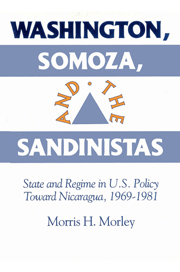Book contents
- Frontmatter
- Contents
- Acknowledgments
- 1 Introduction: Permanent and transitory interests in U.S. foreign policy
- 2 Washington and the Somoza dynasty: From consolidation to crisis of a client dictatorship
- 3 Supporting Somoza: Substance and symbol in American policy during the Nixon-Ford era
- 4 The Carter administration and Nicaragua: Human rights and the politics of accommodation
- 5 The Carter administration and Nicaragua: Mediation and the politics of frustration
- 6 Washington ruptures a historic relationship: Dumping the dictator to save the state
- 7 The Carter administration and revolutionary Nicaragua: Containing Sandinista power
- 8 Conclusion
- Bibliography
- Index
7 - The Carter administration and revolutionary Nicaragua: Containing Sandinista power
Published online by Cambridge University Press: 31 March 2010
- Frontmatter
- Contents
- Acknowledgments
- 1 Introduction: Permanent and transitory interests in U.S. foreign policy
- 2 Washington and the Somoza dynasty: From consolidation to crisis of a client dictatorship
- 3 Supporting Somoza: Substance and symbol in American policy during the Nixon-Ford era
- 4 The Carter administration and Nicaragua: Human rights and the politics of accommodation
- 5 The Carter administration and Nicaragua: Mediation and the politics of frustration
- 6 Washington ruptures a historic relationship: Dumping the dictator to save the state
- 7 The Carter administration and revolutionary Nicaragua: Containing Sandinista power
- 8 Conclusion
- Bibliography
- Index
Summary
Introduction
The response of U.S. policymakers to the forces of political and economic nationalism in Latin America has not always been consistent or uniform. Toward some nationalist regimes the attitude has been hostile and conflictive; toward others, Washington has adopted a more accommodative posture and attempted to manage or negotiate outstanding differences. A framework for explaining imperial state behavior must take account of those factors that executive-branch officials view as pivotal in devising policy for dealing with these kinds of regimes.
First, what sectors of the new nationalist government are dominant and, therefore, likely to direct the process of political and socioeconomic change? Where radical guerrillas predominate, the potential for a structural transformation is seen to increase; where civilian political and business leaders take charge, the likelihood of containing the process of change within “acceptable” limits is similarly reinforced.
Second, what forces control the state, especially the coercive institutions? Given that U.S. policymakers have traditionally viewed the military and police apparatuses as the ultimate guarantors of American permanent interests in these societies, the survival of “collaborator” armed forces during periods of political transition assumes the highest priority within the foreign policy bureaucracy. Its replacement by a guerrilla force with no external linkages (to the Pentagon) evokes maximum alarm over the nature and scope of the change process.
Third, how will the new government's policies affect the distribution of political power and class relationships? Washington is likely to be less sympathetic toward a regime intent on changing the existing distribution of political power and pursuing socioeconomic programs that favor workers and peasants at the expense of traditional elites with historic ties to imperial state power centers.
- Type
- Chapter
- Information
- Washington, Somoza and the SandinistasStage and Regime in US Policy toward Nicaragua 1969–1981, pp. 218 - 307Publisher: Cambridge University PressPrint publication year: 1994



